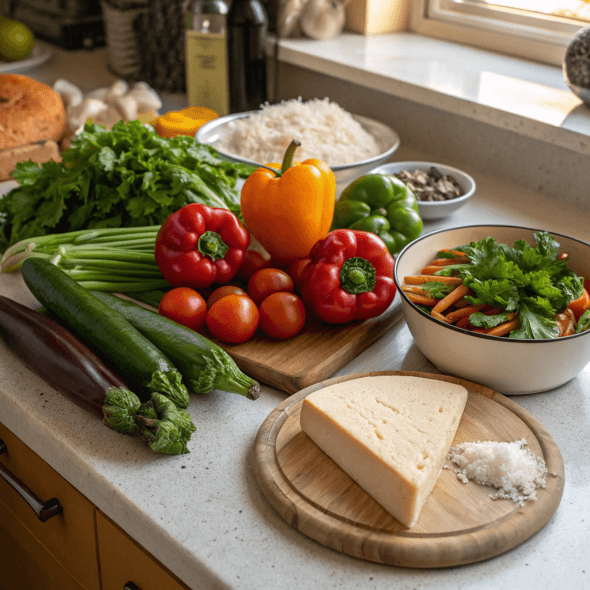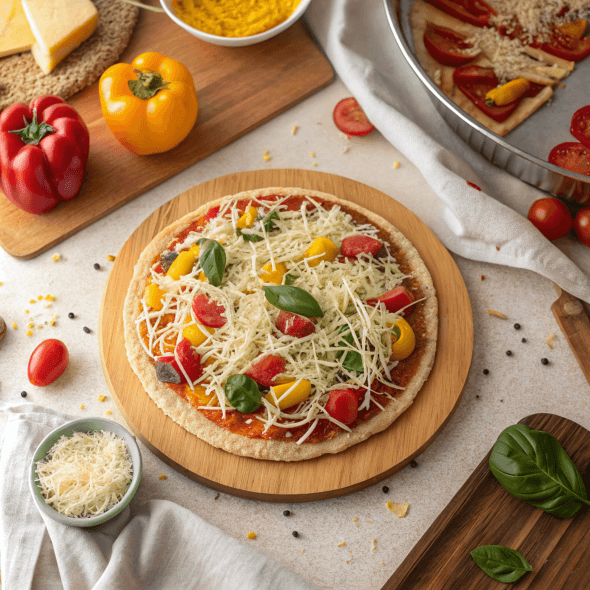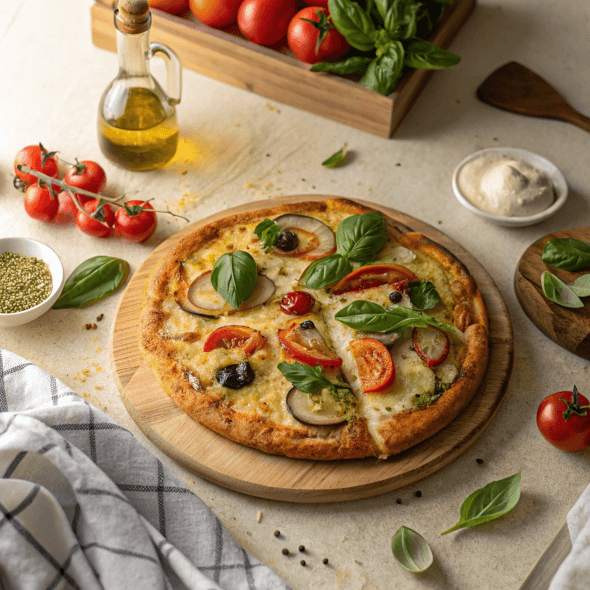Introduction
A vegetarian pizza is more than just a dish—it’s a celebration of vibrant vegetables, gooey cheese, and flavorful sauces. Packed with nutrition and endless customization options, this pizza style has something for everyone. Whether you’re a pizza enthusiast or a beginner, crafting a perfect vegetarian pizza at home is easier than you think. If you’re interested in unique spins on classic pizza dishes, try this three cheese pizza for a hearty take on traditional flavors.
The Story Behind Vegetarian Pizza
Pizza, originating in Naples, Italy, started as a humble dish with basic ingredients like tomatoes and mozzarella. Over time, the use of fresh vegetables transformed it into a global favorite. Today, vegetarian pizza hybrids reflect diverse cuisines, showcasing bold and creative flavors.
Ingredients with Flavor Tips
Essential Ingredients
- Fresh Vegetables: Tomatoes, bell peppers, mushrooms, spinach, onions, zucchini, and olives.
- Cheese Options:
- Mozzarella for creaminess.
- Parmesan for sharpness.
- Feta or goat cheese for tangy accents.
- Vegan cheese for plant-based alternatives.
- Sauce Choices:
- Marinara or tomato sauce for a classic base.
- Pesto for a nutty flavor.
- White sauce for indulgence.
- Herbs and Spices: Basil, oregano, chili flakes, and garlic powder enhance flavor.
Flavor Tips
- Use seasonal vegetables for maximum freshness and taste.
- Balance textures by mixing crunchy vegetables with creamy cheeses.
- Grate cheese fresh for optimal meltability.

Preparation Tools for Vegetarian Pizza
- Pizza Stone or Steel: For an evenly cooked crust.
- Pizza Peel: Makes transferring pizza into the oven easy.
- Grater and Slicer: Essential for prepping cheese and vegetables.
- Rolling Pin: Ensures a uniform dough thickness.
- Mixing Bowls: Ideal for tossing vegetables and combining sauces.
- Thermometer: Helps maintain precise oven temperatures.
Step-by-Step Instructions
1: Prepare the Dough
- Use store-bought or homemade dough.
- Let it rise for an airy, soft crust.
2: Preheat the Oven
- Preheat to 500°F (260°C) with a pizza stone for even heat distribution.
3: Prep Ingredients
- Slice vegetables thinly for uniform cooking.
- Grate your cheese and set aside.
4: Assemble the Pizza
- Roll out the dough on a floured surface.
- Spread a thin, even layer of sauce.
- Sprinkle cheese first, then layer vegetables.
5: Bake
- Bake for 7–10 minutes or until the cheese bubbles and the crust turns golden brown.
6: Garnish and Serve
- Add fresh herbs like basil or arugula before slicing and serving.

Common Mistakes to Avoid
- Overloading Toppings: Leads to uneven cooking and soggy crust.
- Skipping Preheating: Results in inconsistent baking.
- Using Watery Vegetables: Roast or pat them dry to avoid excess moisture.
- Forgetting Fresh Herbs: They add an irreplaceable aroma and flavor.
Creative Variations
- Margherita Pizza: Fresh tomatoes, mozzarella, and basil for a simple yet flavorful option.
- Mediterranean Pizza: Olives, feta cheese, artichokes, and spinach.
- Spicy Veggie Pizza: Jalapeños, chili flakes, and pepper jack cheese.
- Vegan Pizza: Tofu, plant-based cheese, and roasted vegetables.
- Seasonal Specials: Incorporate vegetables like asparagus in spring or pumpkin in fall.
For another indulgent vegetable-forward dish, try these Mashed Potatoes as a side.
Pairing Ideas for Vegetarian Pizza
Side Dishes
- Caesar salad or spinach salad with balsamic dressing.
- Garlic breadsticks or focaccia.
- Roasted vegetables for a hearty addition.
Drink Pairings
- Wine: Pair with a crisp Sauvignon Blanc or a light Pinot Noir.
- Beer: A refreshing wheat beer or lager complements the flavors.
- Non-Alcoholic: Lemonade or sparkling water infused with herbs.
Healthier Alternatives
- Crust Options: Swap traditional dough for whole-grain or cauliflower crusts.
- Cheese Options: Use low-fat cheese or go dairy-free with vegan alternatives.
- Toppings: Add more leafy greens and fewer calorie-dense ingredients.
- Sauce: Opt for oil-free marinara or lightly drizzle olive oil.
Serving and Presentation Tips
- Slice pizza evenly for easy serving.
- Garnish with fresh herbs or arugula for a burst of color.
- Serve on a wooden pizza board for a rustic presentation.
- Add a drizzle of balsamic glaze or chili oil for an extra flavor boost.
FAQ Section
What are the best vegetables for vegetarian pizza?
Tomatoes, mushrooms, bell peppers, spinach, onions, and zucchini are great choices. Seasonal vegetables like asparagus or butternut squash work well too.
How can I make my pizza healthier?
Use a whole-grain or cauliflower crust, opt for low-fat or vegan cheese, and load up on nutrient-rich vegetables.
Can I make a gluten-free vegetarian pizza?
Yes! Use gluten-free dough or a cauliflower crust as a base.
How do I avoid a soggy crust?
Preheat the oven thoroughly, pat vegetables dry, and avoid overloading toppings.
Conclusion
A perfect vegetarian pizza brings together fresh ingredients, creative flavors, and the joy of homemade cooking. Whether you prefer classic Margherita or bold Mediterranean twists, the possibilities are endless. Pair it with our other recipes or enjoy it solo—it’s a meal that never fails to delight. Let your creativity shine and make your next pizza night unforgettable!

